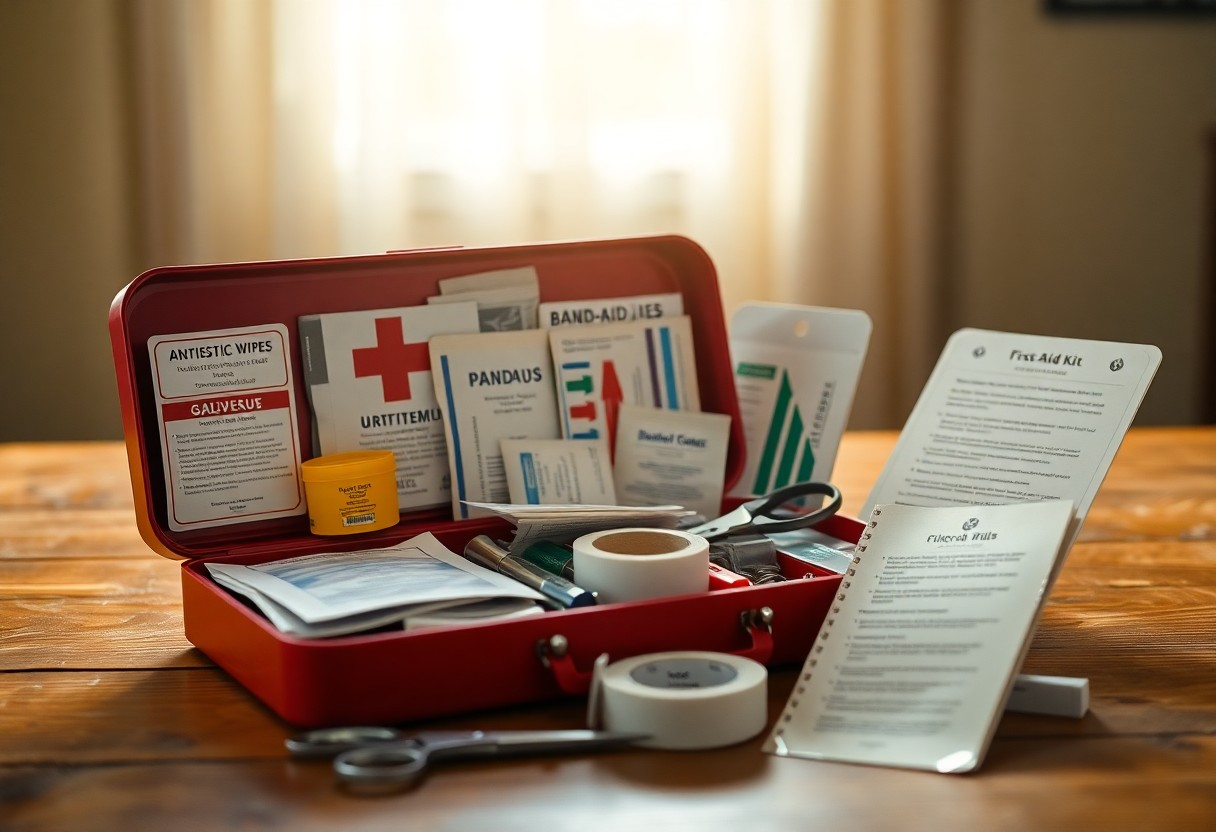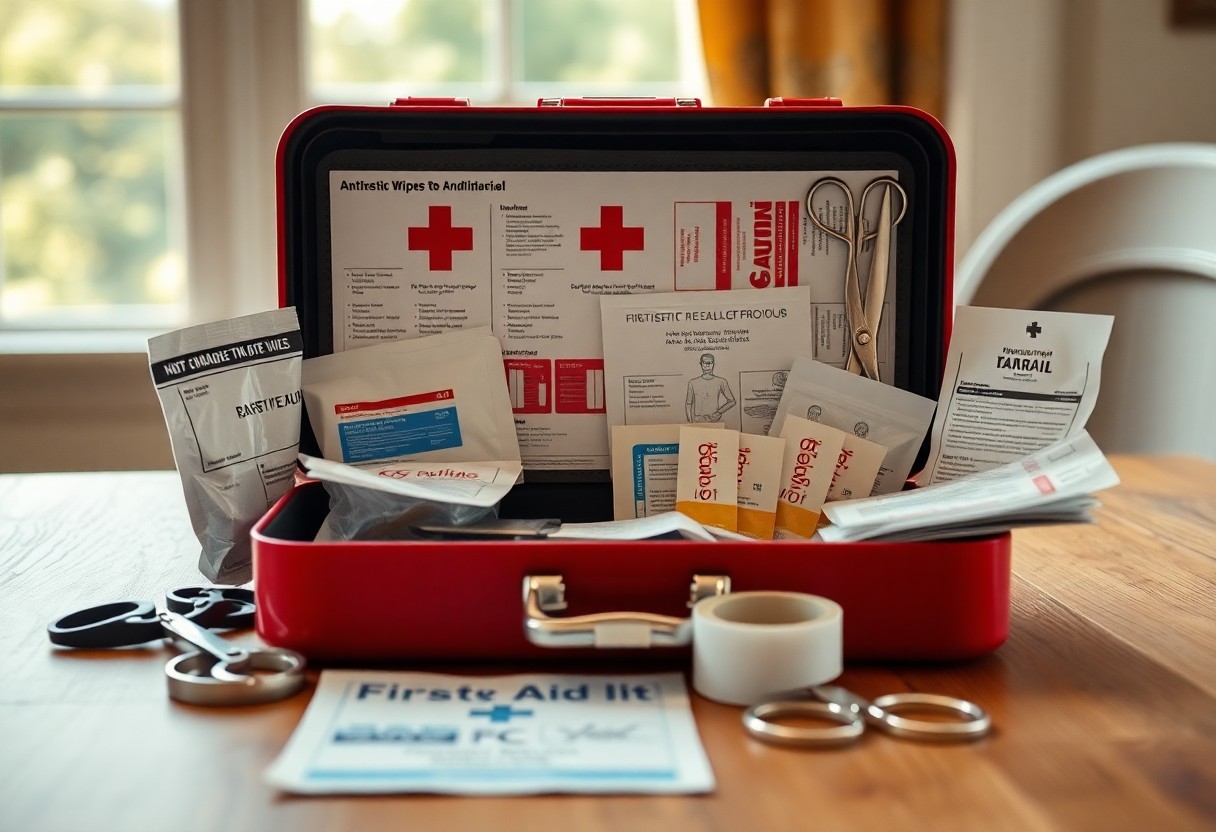Just as you prepare for unexpected situations, having a well-stocked first aid kit is necessary for your safety and peace of mind. Your kit should contain life-saving items such as antiseptics, dressings, and bandages, which can help manage injuries effectively. Understanding the significance of each item and knowing how to use them can make a positive difference in emergencies. In this blog post, we will explore what you should include in your first aid kit and why it matters for your overall well-being.
The Essential Components of a First Aid Kit
Each first aid kit should contain several vital components that cater to various medical emergencies. These items not only prepare you for common injuries, such as cuts and scrapes, but also equip you for more serious situations, including allergic reactions or burns. It’s vital to ensure your kit is suited for your specific needs and is regularly reviewed to replace any used or expired items.
Must-Have Medical Supplies
Your first aid kit should include bandages, adhesive tape, sterile gauze pads, and antiseptic wipes. A reliable pair of scissors, tweezers, and cold packs for swelling or sprains are also vital. Don’t overlook the importance of a comprehensive first aid manual to guide you through emergencies, ensuring you act swiftly and correctly when the situation demands.
Supportive Tools and Accessories
Alongside the medical supplies, supportive tools and accessories bolster your effectiveness during first aid situations. Items like disposable gloves protect you and the injured from infection. A breathable and elastic bandage assists in the management of sprains or strains, while a CPR face shield is vital for performing resuscitation safely. Consider also including an emergency blanket, which helps retain body heat in shock victims or those suffering from hypothermia.
Integrating supportive tools and accessories provides a well-rounded approach to first aid. For instance, a torch can illuminate dark areas, enabling you to assess injuries properly, while a whistle can signal for help in remote locations. Additionally, having a notepad and pen helps document incidents or share vital information with medical professionals later. Such details enhance your preparedness and response when every second counts.

Decoding the Functionality of Each Item
The contents of your first aid kit serve distinct purposes, designed to address various medical scenarios effectively. Understanding how each item functions allows you to respond confidently during emergencies. Every component, from cleansing wipes to adhesive bandages, plays a role in stabilising, protecting, or soothing injuries. This section will dissect how these necessarys can mean the difference between minor discomfort and a major health crisis.
How Bandages and Dressings Save Lives
Bandages and dressings are necessary for controlling bleeding and protecting wounds from infection. They maintain a clean environment, which is vital for the healing process. By applying pressure on a bleeding wound, for instance, bandages can significantly reduce blood loss while offering physical protection to the injured area, ultimately aiding recovery and preventing complications.
The Role of Antiseptics in Infection Prevention
Antiseptics are vital in first aid for combating microorganisms that may enter wounds. Using antiseptic wipes or sprays immediately after an injury can greatly decrease the risk of infection. They work by killing or inhibiting the growth of harmful bacteria, ensuring that your body’s healing process is not compromised by outside threats.
Consider the effectiveness of antiseptics like hydrogen peroxide or iodine-based solutions. A quick application can significantly diminish bacterial presence, thereby reducing the chance of infections that can lead to severe complications, such as sepsis. Keeping these agents accessible within your first aid kit allows you to act swiftly, providing your wounds with the best chance at healing uninterrupted.
Preparing for Allergic Reactions: EpiPens and More
EpiPens are critical for anyone with known allergies, particularly to foods, insect stings, or medications. These auto-injectors deliver a dose of adrenaline, counteracting severe allergic reactions called anaphylaxis. Understanding how to use an EpiPen can be a lifesaver, facilitating immediate response during an emergency, elevating your chance of recovery significantly.
For those at risk of severe allergies, having an EpiPen is non-negotiable. Studies indicate that immediate administration of adrenaline can reduce mortality rates associated with anaphylactic shock by as much as 90%. Pairing your EpiPen with an allergy action plan and education can empower you to manage potential risks effectively, ensuring safety for yourself and loved ones.
Customising Your Kit for Specific Needs
Adapt your first aid kit to reflect specific situations or activities you regularly engage in. Whether you’re an outdoor adventurer, managing a busy household, or working in an office, tailoring your kit ensures that you have immediate access to the required supplies. Consider the types of injuries and emergencies most likely to arise in these settings, and stock your kit accordingly. Personal health conditions, such as allergies or chronic illnesses, should also be taken into account to provide adequate support during emergencies.
First Aid for Outdoor Enthusiasts
If you enjoy hiking, camping, or any outdoor activity, equip your first aid kit with extra supplies like antiseptic wipes, insect repellent, and burn gel. Additionally, including items such as compression bandages for sprains or strains, and a whistle for signalling help is wise. Outdoor injuries can be more complex, so being prepared can make a significant difference.
Tailoring Kits for Home and Workplace Settings
In both home and workplace environments, consider the most common injuries that may occur. For homes with children, for instance, include smaller bandages, thermometer, and even child-safe medication. In offices, having scissors, eye wash, and a variety of bandages can cater to workplace accidents, addressing cuts, and scrapes effectively. Regularly assess your kits to ensure they remain stocked and up-to-date with supplies reflecting the needs of your home or workplace.
The Importance of Regular Maintenance and Updates
Neglecting your first aid kit can lead to a dire situation when you need it most. Regular maintenance ensures that you not only have the necessary supplies but also that they are in optimal condition. An effective first aid kit adapts to the changing landscape of health threats and complies with updated health guidelines, keeping you well prepared for any emergency. This ongoing diligence instils confidence and ensures that your kit remains a reliable resource when every second counts.
Checking Expiry Dates and Performing Inventory
Conducting routine checks on the expiry dates of your supplies should be a priority. Many items, especially medications and sterile equipment, have limited shelf lives. Performing a complete inventory will help you identify which items need replacing, ensuring your first aid kit remains stocked with effective and safe supplies. Set a schedule, perhaps every six months, to keep everything current and accessible.
Adapting to New Threats and Health Guidelines
Your first aid kit should evolve alongside emerging health challenges and guidelines. As new threats such as allergies or endemic diseases arise, the contents of your kit must reflect the current medical landscape. Incorporating items like EpiPens for severe allergic reactions or additional personal protective equipment, such as masks, can make a significant difference in your preparedness.
Staying informed about the latest health recommendations or potential health threats is vital for effective first aid preparedness. For instance, during the pandemic, guidelines for first aid kits expanded to include hand sanitiser, disinfectant wipes, and additional PPE. Adapting your kit as your circumstances and the world change not only increases your safety but also enhances your confidence in handling unwanted emergencies. Conducting research or subscribing to health organisations can keep you well-informed on necessary updates for your first aid supplies.
Engaging the Community: First Aid Training and Awareness
Building a culture of safety within your community involves actively engaging in first aid training and promoting awareness. By offering workshops and demonstrations, you empower your neighbours and friends to respond effectively in emergencies. Local groups can organise events where certified trainers provide hands-on learning experiences that enhance confidence and skills among participants. Creating an environment where first aid is openly discussed can transform how individuals approach emergency situations, ultimately saving lives.
Why Everyone Should Be Trained in Basic First Aid
Basic first aid training equips you with necessary skills that can significantly affect outcomes during emergencies. You gain the ability to administer critical interventions, such as performing CPR or handling minor wounds, which can prevent complications and even save lives. Studies show that in cases of sudden cardiac arrest, immediate CPR can increase survival rates by up to 200%. This training empowers you to act decisively when it matters most.
Collaborating with Local Health Resources
Partnering with local health resources enhances community first aid efforts. By collaborating with organisations such as the Red Cross or local hospitals, you can access materials, expertise, and support for training sessions. This collaboration not only enriches the training experience but also helps establish a reliable network for ongoing health initiatives. Engaging local health professionals for workshops can provide invaluable insights and foster a sense of community spirit, reinforcing the importance of preparedness.
Collaboration with local health resources extends beyond just training; it includes creating a robust support system for emergencies. Establishing connections with healthcare providers allows for streamlined access to medical assistance and information. For instance, having a local doctor or nurse participate in first aid seminars provides participants with firsthand knowledge of current practices and protocols. Furthermore, these partnerships can facilitate community health fairs or free screening events that promote overall health awareness, making your community more resilient in the face of emergencies.
Summing up
So, having a well-stocked first aid kit is crucial for you and your family’s safety. It equips you to handle minor injuries and emergencies effectively, promoting quick recovery and peace of mind. From bandages and antiseptics to tweezers and pain relief, each item serves a specific purpose in managing health situations. Regularly checking and restocking your kit ensures it remains ready when you need it most, enabling you to act confidently in unexpected situations. Your first aid kit is not just a collection of items; it is a foundation for protecting your wellbeing.
